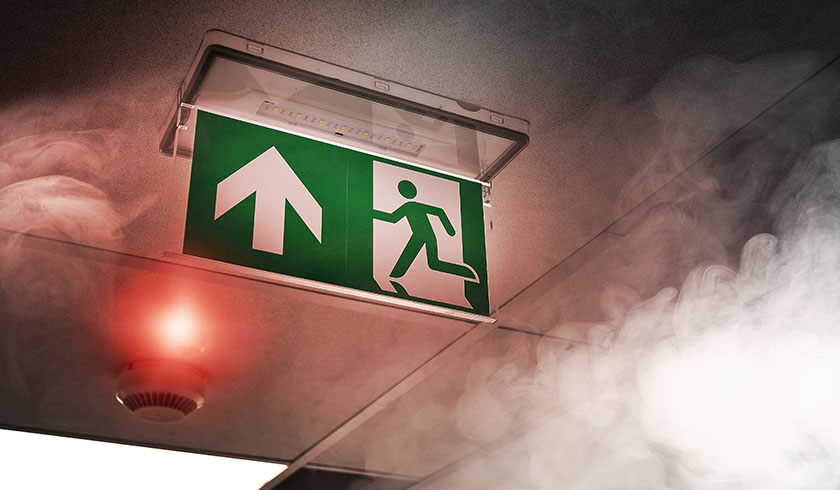Tips to ensure your property is smoke alarm compliant
There are seven ways investors can ensure their properties are up to scratch with smoke alarms.

New research from comparethemarket showed that half of Aussie households don’t check their smoke alarms, leaving properties vulnerable to disaster.
Forty-nine per cent of respondents surveyed admitted that, in the month prior, they did not check that every smoke alarm in their home works. A further 48 per cent did not know that smoke alarms have expiry dates.
The research revealed that younger Australians are taking more fire risks than other age groups. According to the stats, 56 per cent of under-44s did not check their smoke alarms, compared with 43 per cent of 55-64-year-olds, and 40 per cent of over-65s.
State-by-state comparison
Between the states, Western Australian households are most lax in monitoring their smoke alarms, according to the group. Fifty-six per cent of WA households had not checked their smoke alarms at the time of being surveyed.
By comparison, 51 per cent of Victorian respondents had not checked, followed by 48 per cent of NSW respondents and 47 per cent of ACT respondents.
7 tips to minimise your risk, according to comparethemarket
1. Consider installing photoelectric smoke alarms
“Ionisation and photoelectric are the two main types of smoke alarms used in residential properties. In typical house fires, materials can smoulder for a few hours before flames break out. Detecting a fire during this phase can minimise the fire damaging the property or harming occupants.
“Photoelectric smoke alarms are much faster than ionisation alarms at detecting smoke and smoulder. They will respond within three to five minutes compared with up to 20 minutes it takes for ionisation alarms to do the same. Department of Fire and Emergency Services WA recommends installing photoelectric smoke alarms at home,” comparethemarket said.
2. Ensure smoke alarm units are replaced at least once every 10 years
“Due to potential dust build-up, insects and electrical corrosion, smoke alarms may not operate effectively after 10 years.
“To assist in identifying their expiry date, Australian Standard 3786 (the standard for smoke alarms in Australia) requires a serial or batch number to be labelled on the device. For example, 2107 may mean that a device was manufactured in the 21st week of 2007. If you are not sure of the age of your smoke alarm, contact the manufacturer or supplier,” comparethemarket advised.
3. Test smoke detectors regularly
“Smoke alarms should be properly maintained and tested regularly.
“It’s worth setting a reminder in your calendar to ensure you don’t forget about your smoke alarm.
“In some states such as Queensland and WA, residents are urged to check their smoke alarms on 1 April, making it a little bit easier to remember – but it’s advised that smoke alarms are checked monthly. If the alarm doesn’t work, then you will need to replace it immediately,” comparethemarket said.
4. Store chemicals and flammable products correctly
“Designate a cool, dark cupboard for flammable products or chemicals to make sure they are kept away from heat,” the group noted.
“Combustible materials, such as paint or gasoline, should be sealed in their original containers. If you have a garage or shed, take extra care to refuel lawnmowers or garden edgers when they are cold and in the open.”
5. Don’t overload power boards; switch them off when not in use
“Hundreds of house fires are the result of electrical faults each year. Poor maintenance and incorrect usage of power boards – such as overloading them or letting dust build up in unused points – are usually the reasons behind these faults,” comparethemarket noted.
“When using power boards, regularly check that all plugs are firmly fixed in, they receive adequate ventilation, and that they are regularly inspected for signs of damage. Many modern power boards are fitted with a surge protector, and trip switches in household electricity boxes reduce but don’t eliminate the risk of such occurrences.”
6. Never leave stovetops or any other open flames unattended
“Kitchens are some of the most common places in which house fires start, so don’t let any non-cooking flammable items near the oven or stove. For instance, never rest tea towels, oven mitts or cookbooks on the stove top and don’t wear clothes with loose fitting sleeves in the kitchen.
“It’s also crucial to handle candles and any other open flames with extreme care, and make sure they are extinguished before going to bed. Additionally, ensure gas ovens are always switched off to prevent gas leaks or toxin exposure as smoke damage may not be covered by your insurance, unless you have accidental cover included,” comparethemarket said.
7. Have a home escape plan in place
“A fire evacuation plan is crucial to have and recommended by state fire services as it helps save lives in the case of a fire incident. The evacuation plan should be discussed and understood by each household member. It should also be revised and practised in any new property.
“If you live in a multistorey building, the building owner is required to display a fire evacuation plan in plain sight that shows where your ‘assembly area’ is located,” comparethemarket said.
Commenting further, household savings expert Abigail Koch said:
“Working smoke alarms are a necessity all year round, but more so during winter when heating appliances are used.
“A concerning 60 per cent of preventable fires in the home occur overnight, so it’s advised that electric blankets, fireplaces and heaters are turned off before going to bed. It’s vital that Aussies also check the batteries and serial batch number on their smoke alarms for their own safety and wellbeing as they may not operate adequately after a decade, and that they have a fire escape plan.
“It’s important we do everything possible to protect your most valuable asset. A suitable home and contents insurance policy is an important cover in case a fire in the home does occur.”

